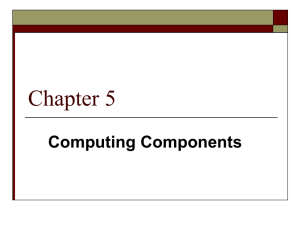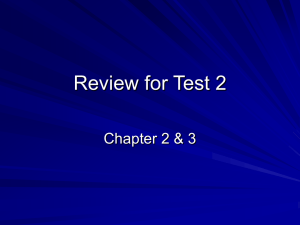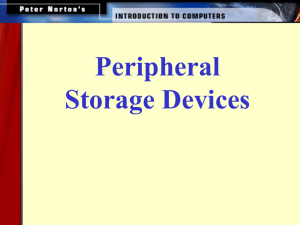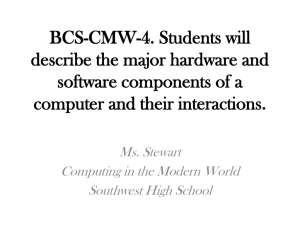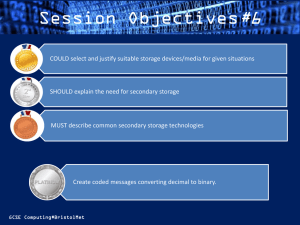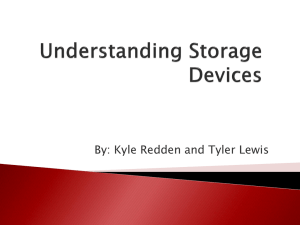Computer Memory and Storage Devices PPT
advertisement
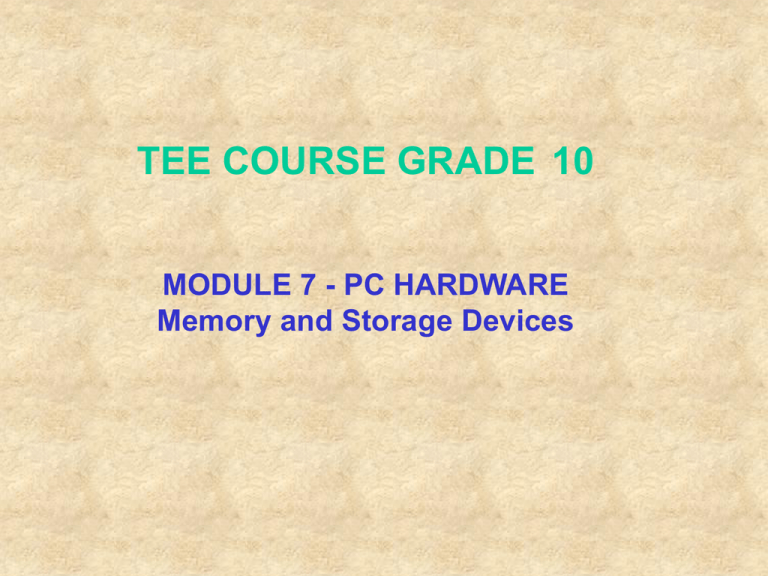
TEE COURSE GRADE 10 MODULE 7 - PC HARDWARE Memory and Storage Devices LEARNING OBJECTIVES At the end of this lesson, students will be able to : 1. Meet the expectations of the Course Curriculum coded as: TFV.01E, TF2.01E, TF2.02E, TF2.03E, TF2.04E, IC1.02E, SPV.01E; 2. Explain the function and interaction of the primary (RAM, ROM) and secondary storage devices (magnetic and optical); 3. Describe secondary storage devices: FDD, HD, CD-ROM, DVD; 4. Use precise terminology in relation to all storage devices; 5. Explain how data is stored on the surface of magnetic and optical disks; 6. Uninstall and re-install main and secondary storage devices: RAM, FDD, HD, CD-ROM; 7. Use safe practices in the handling of computer hardware and electronic components. Short Review Computer System Components Central Processing Unit Input Devices Control Unit ALU Special Primary Cache Purpose Memory Storage Processors Secondary Storage Devices Communication Devices Output Output Devices Devices Three levels of memory hierarchy Principle: the closer the memory is to the CPU, the faster it is. Memory addresses • Memory is a collection of cells, each with a unique physical/memory address • Each cell can hold one byte or 8 bits 101 102 103 201 202 203 301 302 303 With one by we can represent one character in ASCII Code Example: “A” is 65 in ASCII code and 01000001 in binary representation Application/Thinking How many bytes are in the phrase “You are great!” . a) 11 b) 13 c) 14 d) 1 So, this sentence will occupy __?__ cells in memory Storage Capacity Unit -----------kilobyte megabyte gigabyte terabyte petabyte exabyte Exact Number of bytes Approximation -----------------------210 bytes 220 bytes 230 bytes 240 bytes 250 bytes 260 bytes -----------103 bytes 106 bytes 109 bytes 1012 bytes 1015 bytes 1018 bytes Application/Thinking How many megabytes (MB = 2 to the power of 20 bytes) are in a terabyte (1TB = 2 to the power of 40 bytes): a) 2 to the power of 10 b) 2 to the power of 20 c) 2 to the power of 40 d) 2 to the power of 80 PRIMARY MEMORY: RAM AND ROM •RAM (Random Access Memory) is volatile (temporary). Programs and data can be written to and erased from RAM as needed. This means that RAM does not retain its bit configuration when the power is turned off, but ROM does •ROM ( Read Only Memory) is nonvolatile (permanent). The contents in locations in ROM cannot be changed •It holds instructions that run the computer when it is first turned on (BIOS) •The CPU accesses each location in memory by using a unique number, called a memory address. Memory types- RAM • RAM: random access memory – SRAM: static RAM • No need to be refreshed – DRAM: dynamic RAM • Need to be refreshed periodically • Main memory – – – – – SDRAM (Synchronous DRAM) EDRAM (Enhanced DRAM) EDO (Extended Data Out) FLASH RAM Ferroelectric RAM Memory types– ROM • ROM: read-only memory (Pre-programmed) – PROM: programmable ROM • Only written once – EPROM: erasable PROM • Use ultraviolet light to erase data – EEPROM: electronically EPROM • Can be erased using electronic impulses (higher voltages) Secondary Storage Devices • Storage devices hold data, even when the computer is turned off. • The physical material that actually holds data is called a storage medium. The surface of a floppy disk is a storage medium. • The hardware that writes data to or reads data from a storage medium is called a storage device. A floppy disk drive is a storage device. • The two primary storage technologies are magnetic and optical. Magnetic Storage Devices • Diskettes (floppy disks) (FDD) • Hard disks (HD) • High-capacity floppy disks (ZIP Disk) • USB flash drive • Magnetic tape Optical Storage Devices • Compact Disk Read-Only Memory (CD-ROM) • Digital Video Disk Read-Only Memory (DVD-ROM) • CD-Recordable (CD-R) • CD-Rewritable (CD-RW) • PhotoCD CLASSIFICATION- BIG PICTURE Volatile Primary (Semiconductor – chip). Main Memory Memory Types & Storage Devices Registers 2ns Cache (I, II, III) SRAM DRAM SDRAM RAM EDRAM EDO FLASH RAM PROM Non-volatile EPROM ROM EEPROM Tape Magnetic memory HD, Zip Disk Secondary FDD (Devices) CD-ROM, CD-R, CD-RW Optical DVD-ROM, DVD-R Memory DVD- RW 5ms Magnetic Storage Devices - How Magnetic Storage Works • A magnetic disk's medium contains iron particles, which can be polarized—given a magnetic charge—in one of two directions (north or south). • Each particle's direction represents a 1 (on) or 0 (off), representing each bit of data that the CPU can recognize. • A disk drive uses read/write heads containing electromagnets to create magnetic charges on the medium. As the medium rotates, the head writes the data. Magnetic Storage Devices - Diskettes • Diskette drives, also known as floppy disk drives, read and write to diskettes (called floppy disks or floppies). • In disks the areas to save data are organized as a set of concentric circles called Tracks. Floppy disks have 80 tracks. The disks are further divided into pie-slice Sectors. • 300 rpm • Diskettes size: 3.5-inch. Formatted Disk 3.5 inch floppy and drive Hard Disk Drive • Purpose: – Long-term, nonvolatile storage – Large, inexpensive, slow level in the storage hierarchy • Disk composition – A magnetic disk consist of a collection of platters (1to 20 per disk) that rotate on a spindle. – Disk surface divided into tracks (1000 to 4800 per platter). – Tracks are divided into sectors (64 per track), which are the smallest unit that can be read or written. • Up to 10,000 rpm Magnetic Disks • A read/write head travels across a spinning magnetic disk, retrieving or recording data The organization of a magnetic disk Optical Storage Devices – How Optical Storage Works • An optical disk is a high-capacity storage medium. An optical drive uses reflected light to read data. • To store data, the disk's metal surface is covered with tiny dents (pits) and flat spots (lands), which cause light to be reflected differently. • When an optical drive shines light into a pit, the light cannot be reflected back. This represents a bit value of 0 (off). A land reflects light back to its source, representing a bit value of 1 (on). 1 0 Optical storage devices • CD-ROM: compact disc ROM (Read Only Memory) – Capacity: 650MB • CD-R: compact disc recordable • CD-RW: compact disc rewritable • DVD: digital versatile disc – Capacity: 4.7GB – 17GB • DVD-R • DVD-RW (2 versions: + (plus) and – (dash) DVD (Digital Versatile Disk) – Allows up to 17 gigabytes of storage (from 4.7 GB to 17 GB). – Compatible with older CD-ROM technology. – The four versions of the DVD: lesson Review • List four types of magnetic and four types of optical storage devices. • Identify two common uses for floppy disks. • Explain how data is stored on the surface of magnetic and optical disks. • List three variations on optical disk technology. EVALUATION 1. Cache memory has the fastest speed: T 2. A TB has 1024 MB? T 3. EPROM is a volatile memory? T 4. SRAM needs to be refreshed? T 5. EEPROM use ultraviolet light to erase data?T 6. A land reflects light back to its source, representing a bit value of 1 (on). T 7. A pit, does not reflect the light back and this represents a bit value of 0 (off). T F F F F F F F EVALUATION – SHORT TEST cont’ed 8. Define the following acronyms: • • • • • • • • • • • • SRAM ______________________________ DRAM ______________________________ SDRAM ______________________________ EDRAM ______________________________ PROM ______________________________ EPROM ______________________________ EEPROM ______________________________ CD-ROM ______________________________ HDD ______________________________ FDD ______________________________ DVD RW ______________________________ CD-RW ______________________________

